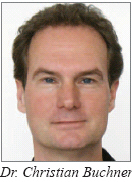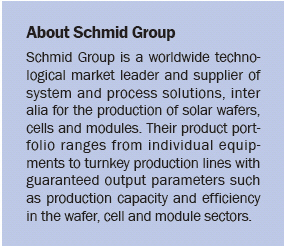By Dr. Christian Buchner
.jpg)
 A Good Choice: The Combined Printing and Etching Technology A Good Choice: The Combined Printing and Etching Technology
The technology developed by the Schmid Group is an etch-back process which converts the previously applied low-resistance emitter into a selective emitter with high-resistance areas and low-resistance grid structures, by selective back-etching. These additionally required process steps are simply inserted between the known process of doping and passivation.
In the first step of the process, a wax mask is applied by an inkjet printer. The SE Jet prints any pattern contact-free onto the surface (Figure 1) which, later, forms the grid of the solar cell.
The wax mask protects the underlying low-resistance emitter during the subsequent back-etching process and, thus, creates the conductive contact to the busbars and fingers which are subsequently applied in a screen printing process.
This is followed by the back-etching of the emitter and the stripping of the wax mask. In the following rinsing process, all chemical residue is removed. These processes are known from other wet-chemical methods and are very easy to control.
The particular advantage of back-etching lies in the complete removal of the so-called dead layer. This top layer of the emitter with a thickness of about 40 nm shows no distinctive semiconducting characteristics which, therefore, makes it unsuitable for the formation of electron-hole pairs.
Experience with the systems already installed has shown that this technology produces not only excellent results on mono-crystalline wafers but also a substantial efficiency increase on high-quality multi-crystalline material. Particular attention should in any case be paid to the measurement technology, as explained in the following.

Where There Is Light, There Is Shade--Limits of Measurement Technology
As a consequence of the improvements achieved in the mass production of solar cells enabling a higher yield of sunlight, the necessity for more precise measuring equipment has arisen to reproduce this light. This is because powerful artificial suns such as e.g., Xenon flashers also have their shady sides: compared to the normed Standard Test Conditions (STC) according to IEC 60904-3 they show significant deviations in the lower and upper range of the spectrum (Figure 2).


They are, however, still being used for quality assessment in cell and module production lines even though the fluctuations between measuring equipment lamps and the norm have been known for a long time.
For example, an analysis carried out in 2009 by the Fraunhofer institute for solar energy systems (ISE)1) in cooperation with major German cell manufacturers and suppliers of measuring technologies brought the physical causes of incorrect measurements in cell and module manufacture to light, hereby naming the Spectral Mismatch as a critical factor2).
The industry is well advised to take the topic of Spectral Mismatch seriously, as becomes evident in the example of selective emitter etching. This young technology which has already roused considerable interest among cell producers, achieves promising efficiency gains of up to 0.8% in the light spectrum under 450 nm. As standard measuring equipment can hardly stimulate the solar cell in this range, efficiency gains remain practically negligible.
If cell manufacturers are not aware of the technical limits of their measuring equipment, this can be fatal. Process engineers must then assume that the ‘lost’ efficiency increase is due to a lacking passivation of the selectively etched emitter layer because in particular the electron-hole pairs generated by short-wave light in the emitter have the tendency to recombine very quickly, and, thus, require a reliable passivation. This is controlled by the thickness of the Silicone Nitride layer (SiNx layer). This means that the thickness of this layer is adapted to achieve a maximum short circuit current--subject to the measuring equipment used. However, a very recent, as yet unpublished joint research project carried out by the University of Konstanz and the Schmid Group who have been studying the effects of the Spectral Mismatch in actual practice, shows that the improvement achieved in this way under artificial sunlight constitutes a worsening of the measurements taken under normed sunlight.
 The Schmid Group is now focusing on passing this information on to cell manufacturers. Ideally the efficiency of the measuring equipment should be improved in the range of under 450 nm down to far into the ultraviolet range, which currently involves very high costs. It is strongly recommended that cell manufacturers who choose to continue to use standard equipment until these high prices are reduced, take a close look at the weakness of their measuring equipment and do not fail to have reference cells measured in a calibration laboratory. The Schmid Group is now focusing on passing this information on to cell manufacturers. Ideally the efficiency of the measuring equipment should be improved in the range of under 450 nm down to far into the ultraviolet range, which currently involves very high costs. It is strongly recommended that cell manufacturers who choose to continue to use standard equipment until these high prices are reduced, take a close look at the weakness of their measuring equipment and do not fail to have reference cells measured in a calibration laboratory.
The introduction of the Schmid technology with leading manufacturers in Taiwan and China for producing SE cells in the combined printing and etching process are best practice examples. With the easy-to-integrate Schmid equipment, these manufacturers are able to produce highly efficient cells with a degree of efficiency of well over 17% on multi-crystalline and well over 19% on mono-crystalline cells. The achieved high-level efficiency gains and production cost reductions were only possible because the cell manufacturers consistently coordinated their production processes and carried out regular calibration of their equipment. Several of these manufacturers have already ordered upgrade equipment for the second half of 2011. By the end of 2011, the Schmid Group anticipates an installed capacity of 5.5 GW of their equipment worldwide.
The effects of Spectral Mismatch applicable to the technology of selective emitter etching, apply in a similar way to the improvements achieved through dielectrically passivated and reflective rear sides, which promise a higher output of the upper range of the sun spectrum and do not stop at module production either. With their processes in module production, the Schmid Group shows that only consistent calibration and the use of suitable standard materials for encapsulation ensure the efficiency gains of the selective emitter, also in the module.
Dr. Christian Buchner is CEO of Schmid Technology GmbH and Vice President Business Unit Cell Schmid Group (www.schmid-group.com). Dr. Buchner has Ph.D. in Physics at the University of Heidelberg in 1995 and is specialized in optics and laser physics. He has 7 years of experience in semiconductor industry as VP sales and later CEO of Heidelberg Instruments GmbH. Since 2004, Dr. Buchner has been the CEO of Schmid Technology GmbH responsible for R&D of laser and inkjet equipment. Since 2010, he has taken care of additional responsibility for all solar cell activities within the Schmid Group as Vice President Business Unit Solar Cells.
REFERENCES
1) Fraunhofer institute for solar energy systems ISE, www.ise.fraunhofer.de
2) Warta, W. et al (2009), “Precise Measurement of Solar Cell Performance in Production”, Speech at PVSEC Hamburg, Germany.
For more information, please send your e-mails to pved@infothe.com.
ⓒ2011 www.interpv.net All rights reserved.
|



